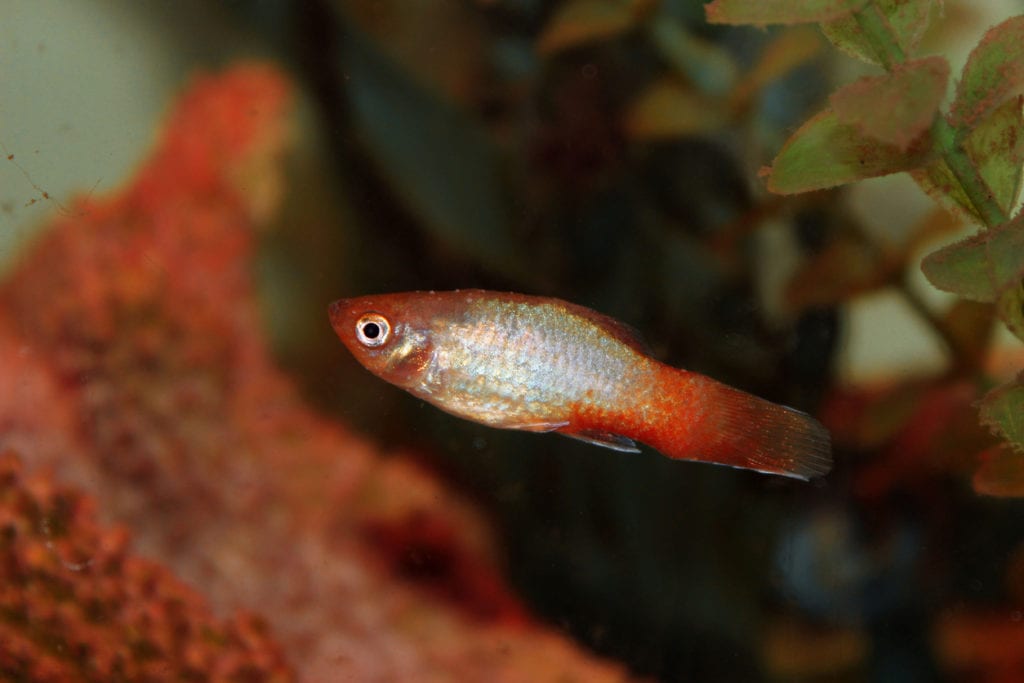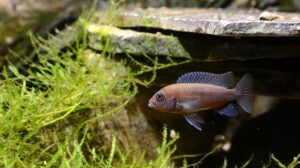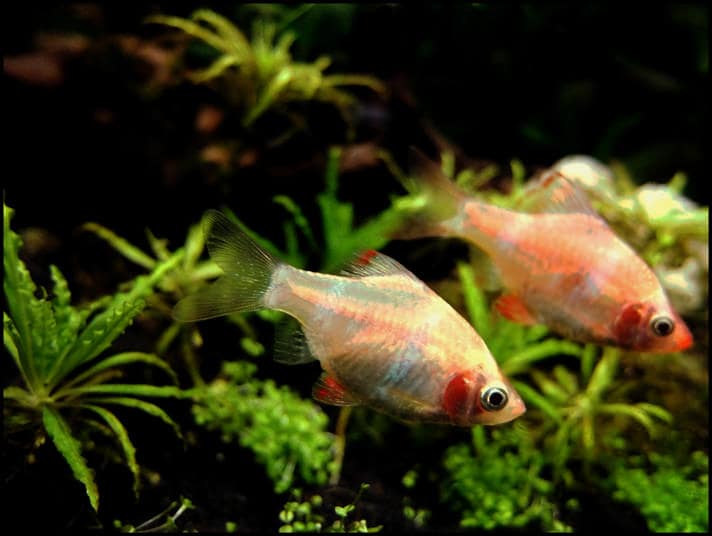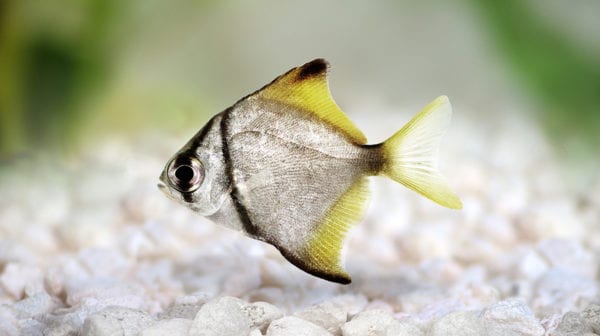Ich on fish is so common, most fish tanks will encounter it at least once. Also known as “white spot disease,” Ich is both quick-spreading and difficult to treat—a two-ingredient recipe for disaster. That’s why early detection and treatment are so important.
BeChewy consulted Dr. Candy Akers, a holistic veterinarian based in Colorado, to get to the tank’s bottom of Ich on fish: how to identify it, how to treat it, and how to prevent it in the first place.
What Is Ich?
Ich (sometimes misspelled “ick,” which seems appropriate) is a common and highly contagious parasitic infection that affects both freshwater and marine fish.
The freshwater form is caused by a microscopic parasite of the same name, Ichthyophthirius multifiliis.
“This microscopic organism infects fish by attaching to their skin, gills or fins and burrowing into the outermost layers of tissue,” Dr. Akers explains. “Once settled, the parasite feeds on the fish’s body fluids and cells, causing the characteristic white spots and other associated symptoms.”
What Causes Ich in Fish?
Ich is caused by the parasite of the same name, Ichthyophthirius multifiliis—a ciliated protozoan, which is an organism with hair-like cilia. But don’t get confused by the fancy science talk. All you need to know is that it is nicknamed “white spot disease” for a reason: It causes white spots (or lesions) on your freshwater fish, particularly in their gills, fins and body surface.
The parasite Ich is more likely to occur if:
- Infected equipment is shared between tanks
- Infected filter is transferred between tanks
- Infected water is shared between tank systems
- Any new fish are introduced
- Infected live plants and/or aquarium decor are introduced to the tank
- Water is between 68℉ and 77℉ (20℃ to 25℃), although it may also infect at temperatures as low as 33℉ (1℃)
Ich lives on the substrate—any loose material that covers the bottom of the tank like pebbles or aquarium gravel—so fish that spend most of their time at the bottom of the tank are most susceptible. As such, Ich is often seen in bottomfeeders like catfish and the burrowing kuhli loach.
Stress is also a contributing factor because it can cause fish to swim to the bottom of the tank, exactly the place where Ich lurks, looking for a new host. There, in the substrate, Ich can easily find a hospitable host in the form of a fish in distress. Stressors include:
- Unsuitable water conditions
- Water changes in temperature
- Overcrowding
“High levels of ammonia, nitrite or nitrate, as well as inadequate oxygen levels, can stress fish and weaken their immune system,” Dr. Akers says. “An overcrowded aquarium can lead to increased competition for resources, higher waste levels and diminished water quality, all of which contribute to stress and increased susceptibility to disease.”
Signs of Ich in Freshwater Fish
- White spots on the fish’s gills, fins and body surface (usually 1mm or 1/32 of an inch, visible to the naked eye, and often look like specks of salt)
- Hiding behavior
- Loss of appetite
- Rubbing or scratching against items in the tank (called “flashing”)
- Bruising or scale loss (usually comes as a result of flashing)
- Other erratic movements
- Bumpy skin on the body surface
- Clamped fins
- Lethargy
- Respiratory trouble
- Gathering around inflowing water
- Sudden death of more than one fish at a time
“Recognizing the signs and symptoms of Ich is crucial for early intervention and successful treatment,” Dr. Akers says.
How To Treat Ich on Fish
While it’s possible to save a tank infiltrated by Ich, it can be difficult. That’s because it depends on the life stage it’s in.
Understanding the Ich Life Cycle
Understanding the life cycle of Ich is crucial to treatment because you can really only treat Ich during one part of its life cycle.
“As the parasite progresses through its life cycle, it reproduces rapidly, increasing the severity of the infection and the risk of spreading to other fish in the same environment,” Dr. Akers says.
Tomont
The tomont stage is when Ich is in the tank environment and reproducing. It has left its fish host, “swims” through the tank and then attaches itself to a surface—usually substrate or an aquarium wall. There, it creates a cyst and inside of that cyst, it divides over and over again, forming as many as 1,000 little parasites called tomites. Tomites mature into theronts that eventually bore out of the cyst, looking for a host.
Theront
The theront stage is when Ich is free-swimming and not visible to the naked eye. No longer protected by the capsule of the cyst, theronts are at their most vulnerable (meaning it’s the easiest stage at which to treat Ich). Theronts are also known as swarmers and though they are vulnerable to treatment at this stage, they can very quickly use their cilia to penetrate a fish’s skin. Should the theront not find a fish host, it will die in the water within a few days. If it does, it digs into the skin and becomes a trophont.
Trophont
Once burrowed, Ich once again becomes more difficult to treat. During the trophont stage, the parasite feeds on the fish’s flesh for three to nine days. There it’s protected by the fish’s own mucus, which provides a barrier that is impermeable to any medication added to the tank. During this phase, the fish experiences severe irritation, and it’s also during this time that the small white spots on the fish appear.
Eventually, the trophont leaves its host and the cycle starts all over again.
How Long Does the Ich Life Cycle Last?
If you’re wondering how long the Ich life cycle takes, the answer is temperature dependent.
Warmer water temperatures help Ich thrive faster than cold temps, although Ich theronts are not usually able to reproduce at water temperatures above 85℉ (30℃).
If the water temperature is higher than 75℉ (24℃), it may take only four days for Ich to fully cycle, though it can take as long as six. At temperatures lower than 45℉ (7℃), it can take anywhere from 18 days to five weeks.
Ich Treatments
Copper Sulfate
Copper sulfate is the key ingredient in any medication for Ich treatment in both freshwater and saltwater tanks. One such product is Fritz Aquatics Mardel Coppersafe Fish Medication, which works on both types of tanks.
“Copper-based medications can be effective against Ich, particularly in marine aquariums,” Dr. Akers says. “However, copper can be toxic to invertebrates and some fish species, so it is important to use these treatments with caution and under the guidance of an aquarium professional.”
Malachite Green
Malachite green, which is found in Kordon’s Malachite Green Fish Disease Control Treatment, is another effective option. “This is a popular and effective treatment for Ich, often used in combination with formalin. Malachite green interferes with the parasite’s metabolism and can be used as a bath treatment or added directly to the aquarium.”
Natural Remedies
A holistic vet, Dr. Akers also adds that there are natural remedies to consider, too.
Crushed garlic: Garlic contains allicin, a compound known for its antimicrobial properties. “Adding crushed garlic to your fish’s food can help boost their immune system, making it harder for the Ich parasite to take hold,” Dr. Akers says.
Indian almond leaves: Indian almond leaves are known for their antifungal, antibacterial and antiparasitic properties. “Adding Indian almond leaves to your aquarium can help create a more natural environment and provide additional support in the fight against Ich,” Dr. Akers says.
How To Prevent Ich (Or White Spot Disease)
Prevention is the most efficient way to ensure that your aquarium never comes down with Ich. To prevent white spot disease, make sure to frequently monitor both water conditions and water temperature.
Check ammonia and nitrite levels: These levels should be at 0. Anything above is toxic and cause for concern.
Maintain water temperature: Freshwater aquariums require a water heater—like the Eheim Thermocontrol E Fish Aquarium Heater. Water temperatures between 77℉ (25℃) and 85℉+ (30℃) are less likely to develop Ich. It’s also important to keep water temperatures stable. Variations (such as between daytime and nighttime temperatures, particularly in the summer) can weaken the fish and make them susceptible to an outbreak.
Quarantine new fish: Ich is commonly introduced into aquariums via new livestock. A fish that’s new to the tank may already be infected and if not properly quarantined first, could infect the entire tank. All incoming fish should be quarantined for at least three days due to Ich’s specific life cycle.
Check on your fish often: Fish that are stressed or weakened are more likely to be overcome with Ich if the two come in contact.
Q:
Can a fish survive Ich?
Q:
Can fish recover from Ich on their own?
Q:
What are the symptoms of Ich on fish?
Q:
What is the recommended treatment for Ich?
Q:
Can Humans Get Ich?
While Ich on fish commonly affects most freshwater aquariums (at least once), it can be tricky to treat. In the event that you see white spots on your fish or other tell-tale signs of Ich, be sure to treat the tank immediately and consider moving fish to a quarantine tank until treatment is complete. Incoming fish should also always be quarantined for at least three days before introducing them to the tank.
If you think your aquarium might be infected, you can always consult an exotic pet veterinarian for more information. Help is available daily through Chewy’s Connect with a Vet telehealth service.
Get advice on caring for your freshwater tank:
Share:













